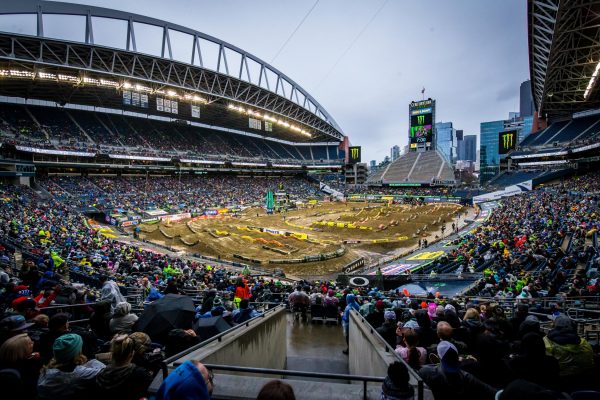FOXBOROUGH, MA – Spring weather in the northeast is ever-changing. It can be warmish and pleasant one day and frigid and snowy the next. It’s not the best time for outdoor events, yet Monster Energy AMA Supercross continues to work to build a fan base in the region and expects a large crowd at Gillette Stadium on  Saturday for an afternoon of racing.
Saturday for an afternoon of racing.
“It is challenging,” said Mike Muye last week of the unpredictable weather situation. As Feld Motor Sports’ senior director of operations for AMA Supercross, Muye oversees the 17-event season that runs from early January until early May. Northeast venues get scheduled as late as possible.
AMA Supercross was last in Foxborough in 2016. Last year, MetLife Stadium in East Rutherford, NJ was the northeast host. “Playing both of those markets (Boston and New York) has been advantageous,” Muye said, explaining that rotating markets can create a larger audience base. He said many fans in the region attended regardless of location.
(For more info: AMA Supercross on Saturday – April 21 at Gillette Stadium.)
AMA Supercross appeals largely to an 18- to 34-year-old crowd (65 percent male and 35 percent female) and families with kids. The sport draws more than 800,000 customers annually and routinely gets 50,000 fans on race days.
If all goes according to plan, work begins today on creating the track inside Gillette Stadium. Plywood goes down on the field first, followed by a six-inch base of ground asphalt. “On Tuesday morning, we start importing the actual racing surface,” Muye explained in a telephone interview.
“The dirt is indigenous to the area. We don’t travel with the dirt. We do look locally,” he said, reporting that a 70 percent clay and 30 percent sand mixture is needed. “If it’s too much clay, it doesn’t soak up moisture well and it becomes too tacky for the riders. Too much sand, it becomes challenging to even build the course.”

A company called Dirt Wurx U.S.A. does the design and construction. It takes 6,500 yards of dirt – 500 truck loads – to make the track. Gillette Stadium has an advantage in that the dirt is stored across the street. “It’s about a half-mile round trip, which is good for us,” Muye said.
“There are no track templates. Every track every year is unique. There are some common elements,” said Muye, explaining that the triple jump is always 70 feet and the spacing on the whoops section is standard as well. “There’s always a consistency for the rider. It’s a safety measure that we take.”
While about 35 workers are involved with the load-in, the number swells to nearly 200 as race day approaches. Eleven production trucks and operations personnel should arrive Tuesday morning. On race day, when teams and crews and even track doctors are present, as many as 250 people can be involved.
“We’re moving 32 race teams, hundreds of people from city to city. Logistics become an important part of the job,” he said.

The biggest challenge in staging Supercross is often the weather. The April 7 races at Century Link Field in Seattle provided a recent challenge. Muye recalled that the forecast leading up to the event called for extensive rain. “We worked with the venue. We had to load in on Sunday night,” he said. The asphalt went in first and at 3 a.m. Monday the crew started hauling dirt. “We built and covered the track with plastic by the end of the day on Tuesday – just to beat the weather that was coming in on Tuesday night.”
Both from a TV ratings standpoint and attendance-wise, AMA Supercross does well “because it’s a consumable sport that happens quickly,” said Muye, who nonetheless is aware that the overall popularity of street riding is declining because baby boomers are aging out and young people aren’t picking up riding.
Consequently, AMA Supercross is working with the Motorcycle Industry Council on initiatives to reverse the trend.
With New York and Boston being huge TV markets – New York ranks No. 1 and Boston ranks No. 9 – it would seem wise for AMA Supercross to adjust its season to better accommodate cold climate cities. (The race circuit doesn’t even visit other Top 10 markets such as Chicago, Philaldephia and Washington, D.C.)
“We have actually had those discussions … to potentially broaden our reach,” said Muye. “I see it being a continuing discussion; maybe some movement over the next few years.”
The gates open Saturday at 8 a.m. at Gillette Stadium with practice and qualifying. Opening ceremonies are set to 2:30 p.m. with heats beginning at 3:11 pm. The 250SX Main Event will be at 4:56 p.m. and the 450SX Main Event at 5:31 p.m.
“It’s a world class show. At the end of the day it’s a fantastic show,” Muye said.
Photos courtesy of AMA Supercross
 Ride CT & Ride New England Serving New England, NYC and The Hudson Valley!
Ride CT & Ride New England Serving New England, NYC and The Hudson Valley!




